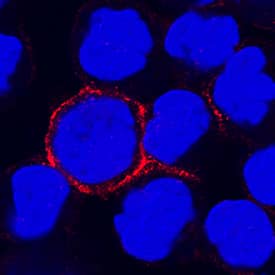Human CD300f/LMIR3 Antibody
R&D Systems, part of Bio-Techne | Catalog # MAB2774


Conjugate
Catalog #
Key Product Details
Species Reactivity
Validated:
Human
Cited:
Human, Mouse
Applications
Validated:
CyTOF-ready, Flow Cytometry, Immunocytochemistry
Cited:
Neutralization, Western Blot
Label
Unconjugated
Antibody Source
Monoclonal Rat IgG2B Clone # 234903
Product Specifications
Immunogen
Y3 rat myeloid cell line transfected with human CD300f/LMIR3
Specificity
Detects human CD300f/LMIR3 in direct ELISAs. In direct ELISAs, no cross-reactivity with recombinant human LMIR1, 2, 4, 5, 6, or recombinant mouse LMIR3 is observed.
Clonality
Monoclonal
Host
Rat
Isotype
IgG2B
Scientific Data Images for Human CD300f/LMIR3 Antibody
CD300f/LMIR3 in Human PBMCs.
CD300f/LMIR3 was detected in immersion fixed human peripheral blood mononuclear cells (PBMCs) using Rat Anti-Human CD300f/LMIR3 Monoclonal Antibody (Catalog # MAB2774) at 15 µg/mL for 3 hours at room temperature. Cells were stained using the NorthernLights™ 557-conjugated Anti-Rat IgG Secondary Antibody (red; Catalog # NL013) and counterstained with DAPI (blue). Specific staining was localized to cell surfaces. View our protocol for Fluorescent ICC Staining of Non-adherent Cells.Applications for Human CD300f/LMIR3 Antibody
Application
Recommended Usage
CyTOF-ready
Ready to be labeled using established conjugation methods. No BSA or other carrier proteins that could interfere with conjugation.
Flow Cytometry
0.25 µg/106 cells
Sample: Human whole blood monocytes
Sample: Human whole blood monocytes
Immunocytochemistry
8-25 µg/mL
Sample: Immersion fixed human peripheral blood mononuclear cells (PBMCs)
Sample: Immersion fixed human peripheral blood mononuclear cells (PBMCs)
Formulation, Preparation, and Storage
Purification
Protein A or G purified from hybridoma culture supernatant
Reconstitution
Reconstitute at 0.5 mg/mL in sterile PBS. For liquid material, refer to CoA for concentration.
Formulation
Lyophilized from a 0.2 μm filtered solution in PBS with Trehalose. *Small pack size (SP) is supplied either lyophilized or as a 0.2 µm filtered solution in PBS.
Shipping
Lyophilized product is shipped at ambient temperature. Liquid small pack size (-SP) is shipped with polar packs. Upon receipt, store immediately at the temperature recommended below.
Stability & Storage
Use a manual defrost freezer and avoid repeated freeze-thaw cycles.
- 12 months from date of receipt, -20 to -70 °C as supplied.
- 1 month, 2 to 8 °C under sterile conditions after reconstitution.
- 6 months, -20 to -70 °C under sterile conditions after reconstitution.
Background: CD300f/LMIR3
References
- Clark, G.J. et al. (2009) Trends Immunol. 30:209.
- Sui, L. et al. (2004) Biochem. Biophys. Res. Commun. 319:920.
- Alvarez-Errico, D. et al. (2004) Eur. J. Immunol. 34:3690.
- Korver, W. et al. (2009) Leukemia 23:1587.
- Izawa, K. et al. (2009) J. Immunol. 183:925.
- Alvarez-Errico, D. et al. (2007) J. Immunol. 178:808.
- Can, I. et al. (2008) J. Immunol. 180:207.
- Izawa, K. et al. (2007) J. Biol. Chem. 282:17997.
- Shi, L. et al. (2006) Blood 108:2678.
- Xi, H. et al. (2010) J. Exp. Med. 207:7.
Long Name
Leukocyte Mono Ig-like Receptor 3
Alternate Names
CD300f, CD300LF, CLIM1, CLM1, DIgR2, IGSF13, IREM-1, LMIR3, NKIR, Pigr3
Gene Symbol
CD300LF
Additional CD300f/LMIR3 Products
Product Documents for Human CD300f/LMIR3 Antibody
Product Specific Notices for Human CD300f/LMIR3 Antibody
For research use only
